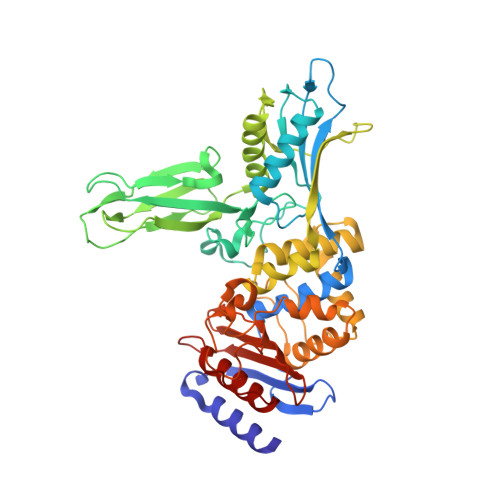Unexpected Tricovalent Binding Mode of Boronic Acids within the Active Site of a Penicillin- Binding Protein.
Zervosen, A., Herman, R., Kerff, F., Herman, A., Bouillez, A., Prati, F., Pratt, R.F., Frere, J.M., Joris, B., Luxen, A., Charlier, P., Sauvage, E.(2011) J Am Chem Soc 133: 10839
- PubMed: 21574608
- DOI: https://doi.org/10.1021/ja200696y
- Primary Citation of Related Structures:
2Y4A, 2Y55, 2Y59, 3ZVT, 3ZVW - PubMed Abstract:
Boronic acids bearing appropriate side chains are good inhibitors of serine amidohydrolases. The boron usually adopts a tetrahedral conformation, bound to the nucleophilic serine of the active site and mimicking the transition state of the enzymatic reaction. We have solved the structures of complexes of a penicillin-binding protein, the DD-peptidase from Actinomadura sp. R39, with four amidomethylboronic acids (2,6-dimethoxybenzamidomethylboronic acid, phenylacetamidomethylboronic acid, 2-chlorobenzamidomethylboronic acid, and 2-nitrobenzamidomethylboronic acid) and the pinacol ester derived from phenylacetamidomethylboronic acid. We found that, in each case, the boron forms a tricovalent adduct with Oγ of Ser49, Ser298, and the terminal amine group of Lys410, three key residues involved in the catalytic mechanism of penicillin-binding proteins. This represents the first tricovalent enzyme-inhibitor adducts observed by crystallography. In two of the five R39-boronate structures, the boronic acid is found as a tricovalent adduct in two monomers of the asymmetric unit and as a monocovalent adduct with the active serine in the two remaining monomers of the asymmetric unit. Formation of the tricovalent complex from a classical monocovalent complex may involve rotation around the Ser49 Cα-Cβ bond to place the boron in a position to interact with Ser298 and Lys410, and a twisting of the side-chain amide such that its carbonyl oxygen is able to hydrogen bond to the oxyanion hole NH of Thr413. Biphasic kinetics were observed in three of the five cases, and details of the reaction between R39 and 2,6-dimethoxybenzamidomethylboronic acid were studied. Observation of biphasic kinetics was not, however, thought to be correlated to formation of tricovalent complexes, assuming that the latter do form in solution. On the basis of the crystallographic and kinetic results, a reaction scheme for this unexpected inhibition by boronic acids is proposed.
- Centre de Recherches du Cyclotron, Université de Liège, B-4000 Sart Tilman, Liège, Belgium.
Organizational Affiliation:




















